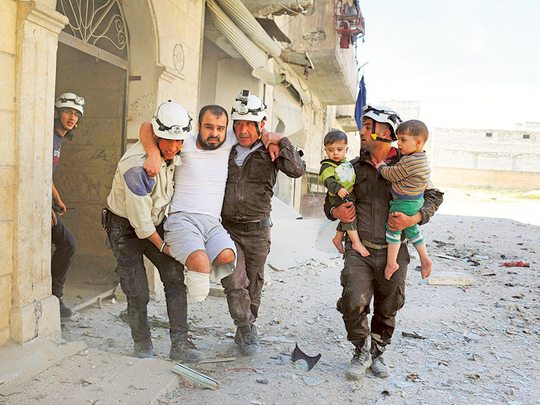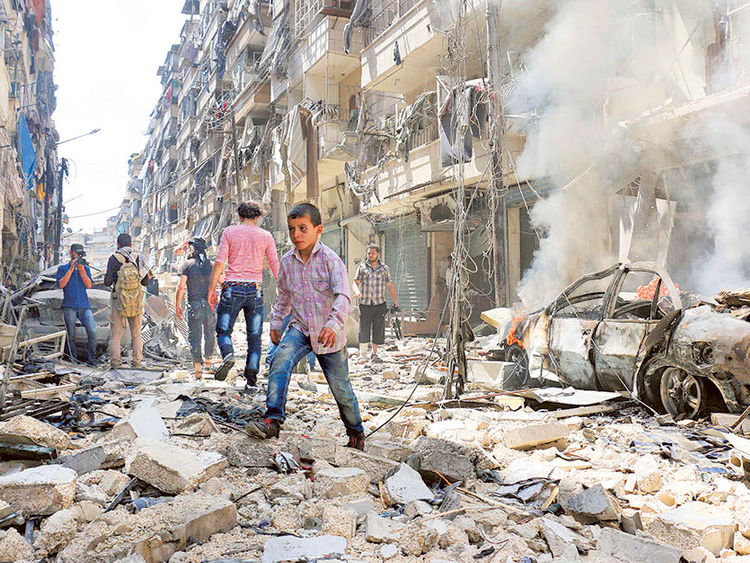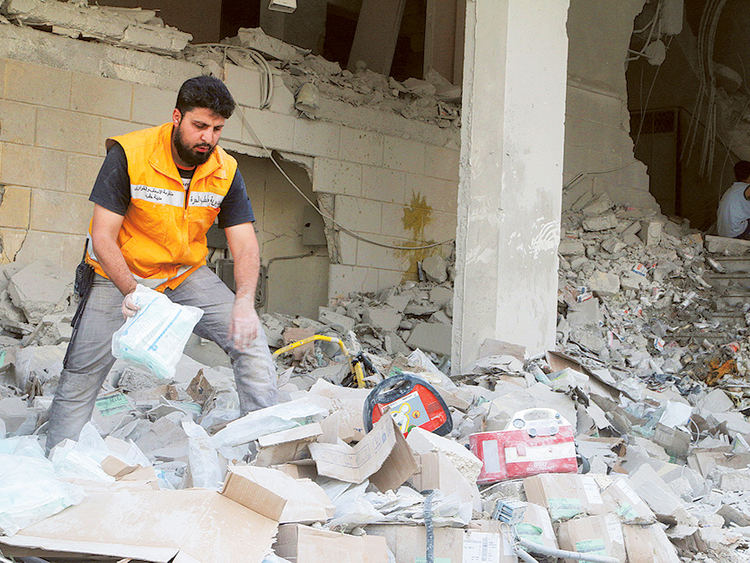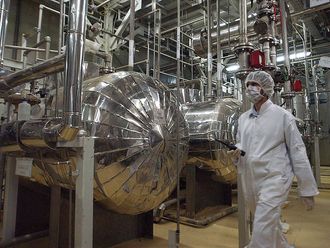
Gaziantep, Turkey: The president of Aleppo city council, Brita Haji Hassan, had a picture on his phone. It showed the corpse of Hasan Amory, 29, a father of two and council engineer, who that morning had been killed by a Syrian air force missile as he headed to work in a stronghold of the opposition.
“We have had massacres on a daily basis for six or seven days,” Haji Hassan said during an interview in the Turkish city of Gaziantep, 50 kilometres from the Syrian border.
“They are destroying schools and civilian targets using barrel bombs, air strikes and machine guns. Another colleague of mine was killed yesterday while I spoke to him on Skype.”
As the most senior civic leader in Aleppo, Haji Hassan has been trying to make life liveable in the most impossible and dangerous of circumstances. “It is a terrible situation,” he said. “But we are trying to live.”
Syria’s largest city is once again under bombardment: its residents are, once again, exposed to pitiless, wanton attack as the world looks on. The ferocity and cruelty of the bombing of Aleppo by President of Syria Bashar Al Assad’s air force has shocked even those familiar with the worst of this conflict.
Since breaking its ceasefire nine days ago, the regime has launched more than 260 air strikes, 110 artillery strikes and 18 missiles, and has dropped 68 bombs, according to the Civil Defence organisation in opposition-controlled Syria known as the White Helmets.
Aleppo has been excluded from a partial ceasefire agreed elsewhere in the country late on Friday evening. On Saturday, the regime’s air strikes began at around 10am with a volley of seven missiles hitting civilian areas in the space of half an hour, killing at least six people and injuring 20. That came after attacks on Friday left at least eight people dead and destroyed a medical facility and a water pump, threatening the city’s vital supplies, according to reports.
On Thursday, bombs destroyed a hospital backed by Medecins Sans Frontieres and the International Committee of the Red Cross, killing the city’s last remaining paediatrician, along with 26 other people, including three children.
Staffan de Mistura, the UN envoy for Syria, declared the cessation of hostilities agreement brokered by the US and Russia as “barely alive” as a result.
The UK’s special representative for Syria, Gareth Bayley, tweeted: “#Russia needs to get control over the #Assad regime’s attacks on civilians.”
Such is the onslaught that humanitarian organisations are considering pulling out of Syria’s biggest city. A draft statement being circulated among nongovernment organisations (NGOs) warns of a “complete absence of the fundamentals of safe humanitarian intervention, and the absence of a clear mechanism to monitor and document violations of international humanitarian law and human rights law”.
It further claims that there is “growing, recurrent targeting of humanitarian organisations, teams, and the vital centres that provide services to civilians in the province, by the Syrian regime and its allies”.
It goes on: “The most recent assaults included the shelling of Syrian Civil Defence centres, Al Quds children’s hospital, NGOs’ ambulance systems, and a number of administrative offices of the NGOs operating in the province.”
The UN high commissioner for human rights, Prince Zeid Ra’ad Al Hussein, on Saturday condemned the “monstrous disregard for civilian lives” by all parties to the conflict and called for urgent de-escalation.
The Syrian Observatory for Human Rights, a British-based monitoring group, puts the civilian death toll in government and rebel bombardments of districts in Aleppo since April 22 at nearly 250.
This figure includes around 140 people killed by government-aligned forces in air strikes and shellings of rebel-held areas, 19 of them children, it said. Insurgent shelling of government-held areas was said to have killed 96 people, including 21 children, according to a report from Reuters.
Al Hussein also made reference to widespread rumours that new Russian artillery sites were being established on the outskirts of Aleppo. “The violence is soaring back to the levels we saw prior to the cessation of hostilities,” he said. Haji Hasan confirmed that Aleppo was under partial siege, and that the last remaining road had been under almost constant attack since the two-month ceasefire between opposition and regime forces was broken by Assad. He said that he had heard about the Russian build-up on the periphery of the city but that he could not confirm this presence.
“In 2013 there were two million people in and around the city,” he said. “There are 400,000 right now. Some people just fled, but these 400,000 won’t leave — even though they know that at any time they could be bombed or killed. It is semi-siege right now. The only road connecting Aleppo is always targeted by air strikes, the Castello road. This road is targeted by air strikes and snipers, too. It is a dangerous road, but we have to use it, there is no other. If that goes, we will be besieged. It will be a disaster.”














